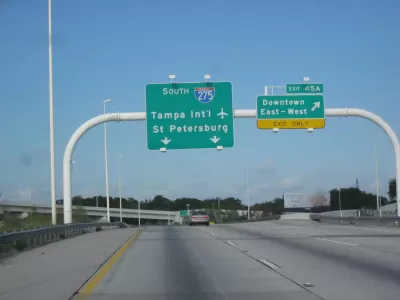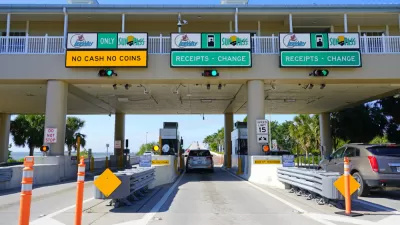Florida has the distinction of having more toll roads than any other state. Environmentalists want Gov. DeSantis (R) to veto a bill that would build three new ones, adding over three hundred miles of asphalt through mostly rural, unpopulated areas.

The Sierra Club calls the 330 miles of proposed public toll roads, the largest road project in the Sunshine State since the construction of the nearly 500-mile Florida's Turnpike, the “roads to ruin."
The legislation authorizing their construction, Senate Bill 7068 by Senate President Bill Galvano, R-Bradenton, refers to them as "Multi-use Corridors of Regional Economic Significance," and supporters assert that they "will spur economic development, provide new hurricane evacuation routes and ease congestion on Interstate 4 and Interstate 75, main thoroughfares tourists use to get to Walt Disney World," reports Skyler Swisher for the Sun Sentinel.
SB 7068 passed the legislature on May 1 and was presented to Gov. Ron DeSantis on Monday, May 13. He has until May 28 to act.
DeSantis’ veto pen is perhaps [environmentalists'] last chance to halt the road-building plan. The new Republican governor has styled himself as a Teddy Roosevelt-style conservationist. In a move that surprised some, DeSantis vetoed a bill that would have prohibited cities from banning plastic straws.
"The proposed routes pass through what are now cattle pastures, citrus groves, and pine forests," wrote Daniel Herriges for Strong Towns (posted here May 2).
The largest city on the longest of the three routes—Perry—has fewer than 10,000 inhabitants...There is absolutely no present, looming problem that these toll roads would solve. None
Thomas Hawkins [AICP] of 1000 Friends of Florida makes a collection of arguments against these roads concisely and eloquently in this Gainesville Sun op-ed. I won't reinvent Hawkins's wheel in this post—I recommend reading his op-ed.
On the other side, "[b]usiness groups are urging the governor to sign the bill, saying the highway expansion is needed with 3 million new drivers projected to hit roadways by 2030," adds Swisher.
We need to plan smart and work fast to keep up with Florida’s growth or risk becoming like California,” Mark Wilson, president and CEO of the Florida Chamber of Commerce, said in a prepared statement. [Editorial note from a Californian: California's problem is a lack of homes, not asphalt.]
The April 15 legislative analysis [pdf] makes it clear that the bill is meant to improve, if not redirect, infrastructure funding from the urban to the rural areas of the state that haven't seen the economic growth that more developed areas of the state have experienced.
“With a lack of diversity in the economy, you’re ending up with areas where there is a death of new population growth," states Galvano in an extensive article by in Florida Politics on the bill and Sierra Club protests urging a gubernatorial veto. Galvano stresses how these "corridors of regional economic significance" will "enhance surrounding communities" in the infrastructure section of his May 4 press release on the conclusion of the 2019 legislative session.
Three new public toll roads
- The Suncoast Connector, the longest of the three, would extend the Suncoast Parkway from Citrus County in the Tampa Bay Area to Jefferson County at the Georgia state line. [See Planetizen: "Toll Road Cautionary Tale: Florida's Suncoast Parkway,"]
- The Northern Turnpike Connector, the shortest, would extend the northern terminus of Florida's Turnpike at Interstate 75, northwest to the Suncoast Parkway.
- The Southwest-Central Florida Connector would be a new expressway running from Collier County in southwest Florida to Lakeland in Polk County, midway between Tampa and Orlando on Interstate 4.
The last road proposal is not new. Known as the Heartland Parkway, "[f]ormer Gov. Charlie Crist [now congressman] killed it in 2007," reported Craig Pittman for the Tampa Bay Times in an extensive article on Feb. 18.
The Florida Department of Transportation killed it in 2011 and again in 2015. Then Crist’s successor, Rick Scott [now U.S. Senator], nixed it one more time in 2016. It is supposed to be kaput.
Galvano, in an interview, said he wasn't specifically thinking of the Heartland Parkway, but something following that same route that would also bring in water and sewer lines to rural areas now using wells and septic tanks. He wants $125 million to get the planning started.
"Construction would start in 2022, and the thoroughfares should be open to traffic no later than the end of 2030, according to the bill," adds Swisher.
Toll road finance
The new roads would require $45 million in the 2020 budget year, rising to $90 million the next year and then to $135 million annually through 2030. The money would be drawn from motor vehicle license taxes [pdf].
However, the project will also divert general fund revenue outright, and also by redirecting the aforementioned license fees. The April 15 legislative analysis [pdf] indicates that it would "redirect portions of motor vehicle license taxes currently deposited into the General Revenue Fund to the State Transportation Trust Fund".
According to Strong Towns' Herriges, the roads "would divert over $1.3 billion from the state's general fund to pay for them."
Political journalist Scott Powers writes in Florida Politics on March 5 that the "bill would reserve up to $109 million a year from license plate fees and another $35 million a year from general revenue money to pay for those and related roads."
That money plus future tolls would pay for them. All the projects are envisioned as toll roads that would join the state’s toll road system under Florida’s Turnpike Enterprise.
However, Pittman of the Tampa Bay Times reminds readers of the questionable revenue projections of toll roads in Florida.
Florida has more toll roads by mile than any other state. They were built as an alternative to regular highways because in theory they pay for themselves. Yet several of the state’s toll roads— including the Suncoast Parkway — have failed to attract enough drivers to cover their cost. One toll bridge in the Panhandle missed financial projections so badly it went bankrupt.
In a separate article in February 2016 (posted here), Pittman analyzed projections made by the Florida Department of Transportation on the Tampa Bay Express (TBX) project which would have added "90 miles of toll lanes to otherwise free highways — Interstates 4, 275 and 75 — in Pinellas and Hillsborough counties." Note that this was a highway widening with toll lanes, as opposed to new toll road construction.
Growth management legislation
Finally, Swisher of the Sun Sentinel notes that "[e]nvironmentalists also rallied against HB 7103, which would make people challenging a city’s development plan liable for the other side’s attorney’s fees if they lose." It also "could restrict local governments’ ability to create affordable housing units," according to the Tampa Bay Times.
Thomas Hawkins' of 1000 Friends urges Santis to veto the bill in an opinion in TCPalm.
Related in Planetizen:
-
How Not to Do Growth, May 2, 2019
-
Miami-Dade Wants to Add 13 Miles to the Dolphin Expressway, October 2, 2018
-
Toll Road Cautionary Tale: Florida's Suncoast Parkway, February 9, 2016
- [Sen. Bill Galvano's] Bill to Revise Developments of Regional Impact Process Stalls in Florida, April 25, 2014
Hat tip to David Daniels, Planetizen reader.
FULL STORY: Environmentalists protest massive highway plan as ‘toll roads to nowhere’

Study: Maui’s Plan to Convert Vacation Rentals to Long-Term Housing Could Cause Nearly $1 Billion Economic Loss
The plan would reduce visitor accommodation by 25,% resulting in 1,900 jobs lost.

Alabama: Trump Terminates Settlements for Black Communities Harmed By Raw Sewage
Trump deemed the landmark civil rights agreement “illegal DEI and environmental justice policy.”

Why Should We Subsidize Public Transportation?
Many public transit agencies face financial stress due to rising costs, declining fare revenue, and declining subsidies. Transit advocates must provide a strong business case for increasing public transit funding.

Paris Bike Boom Leads to Steep Drop in Air Pollution
The French city’s air quality has improved dramatically in the past 20 years, coinciding with a growth in cycling.

Why Housing Costs More to Build in California Than in Texas
Hard costs like labor and materials combined with ‘soft’ costs such as permitting make building in the San Francisco Bay Area almost three times as costly as in Texas cities.

San Diego County Sees a Rise in Urban Coyotes
San Diego County experiences a rise in urban coyotes, as sightings become prevalent throughout its urban neighbourhoods and surrounding areas.
Urban Design for Planners 1: Software Tools
This six-course series explores essential urban design concepts using open source software and equips planners with the tools they need to participate fully in the urban design process.
Planning for Universal Design
Learn the tools for implementing Universal Design in planning regulations.
Smith Gee Studio
Alamo Area Metropolitan Planning Organization
City of Santa Clarita
Institute for Housing and Urban Development Studies (IHS)
City of Grandview
Harvard GSD Executive Education
Toledo-Lucas County Plan Commissions
Salt Lake City
NYU Wagner Graduate School of Public Service




























